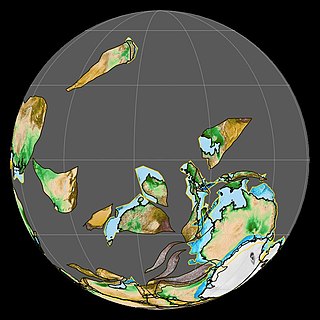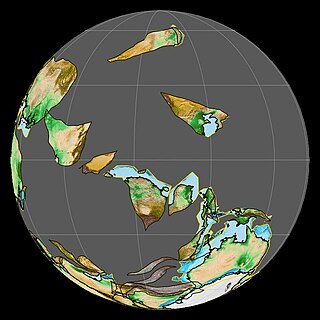Related Research Articles

The Carboniferous is a geologic period and system of the Paleozoic that spans 60 million years from the end of the Devonian Period 358.9 Ma to the beginning of the Permian Period, 298.9 Ma. In North America, the Carboniferous is often treated as two separate geological periods, the earlier Mississippian and the later Pennsylvanian.
In the geologic timescale, the Asselian is the earliest geochronologic age or lowermost chronostratigraphic stage of the Permian. It is a subdivision of the Cisuralian Epoch or Series. The Asselian lasted between 298.9 and 293.52 million years ago (Ma). It was preceded by the Gzhelian and followed by the Sakmarian.
The Bashkirian is in the International Commission on Stratigraphy geologic timescale the lowest stage or oldest age of the Pennsylvanian. The Bashkirian age lasted from 323.2 to 315.2 Ma, is preceded by the Serpukhovian and is followed by the Moscovian.
The Famennian is the later of two faunal stages in the Late Devonian epoch. The most recent estimate for its duration is that it lasted from around 371.1 to 359.3 million years ago. An earlier 2012 estimate, still used by the International Commission on Stratigraphy, is that it lasted from 372.2 million years ago to 358.9 million years ago. It was preceded by the Frasnian stage and followed by the Tournaisian stage.

The Tournaisian is in the ICS geologic timescale the lowest stage or oldest age of the Mississippian, the oldest subsystem of the Carboniferous. The Tournaisian age lasted from 358.9 Ma to 346.7 Ma. It is preceded by the Famennian and is followed by the Viséan. In global stratigraphy, the Tournaisian contains two substages: the Hastarian and Ivorian. These two substages were originally designated as European regional stages.

The Visean, Viséan or Visian is an age in the ICS geologic timescale or a stage in the stratigraphic column. It is the second stage of the Mississippian, the lower subsystem of the Carboniferous. The Visean lasted from 346.7 to 330.9 Ma. It follows the Tournaisian age/stage and is followed by the Serpukhovian age/stage.

The Serpukhovian is in the ICS geologic timescale the uppermost stage or youngest age of the Mississippian, the lower subsystem of the Carboniferous. The Serpukhovian age lasted from 330.9 Ma to 323.2 Ma. It is preceded by the Visean and is followed by the Bashkirian. The Serpukhovian correlates with the lower part of the Namurian Stage of European stratigraphy and the middle and upper parts of the Chesterian Stage of North American stratigraphy.
Taphrognathus is an extinct genus of conodonts from the Dinantian.
Maurice Goldsmith Mehl was an American paleontologist and professor in the Department of Geology at the University of Missouri.
Edwin Bayer Branson was an American geologist and paleontologist. He was a professor of geology at the University of Missouri for 37 years.
Wurmiella is an extinct conodont genus.
Ozarkodina is an extinct genus of conodonts in the family Spathognathodontidae.

Polygnathus is an extinct genus of conodonts.
Palmatolepis is an extinct conodont genus in the family Palmatolepidae. It was the most abundant genus of conodonts of the Late Devonian, disappearing during the Devonian/Carboniferous crisis.

Gnathodus is an extinct conodont genus in the family Idiognathodontidae.
Icriodus is an extinct conodont genus in the family Gnathodontidae.
Conodonts are an extinct class of animals whose feeding apparatuses called teeth or elements are common microfossils found in strata dating from the Stage 10 of the Furongian, the fourth and final series of the Cambrian, to the Rhaetian stage of the Late Triassic. These elements can be used alternatively to or in correlation with other types of fossils in the subfield of the stratigraphy named biostratigraphy.
Scaliognathus is an extinct genus of conodonts.
Patrognathus is an extinct genus of conodonts.
Declinognathodus is an extinct genus of platform conodonts.
References
- ↑ Conodonts. EB Branson and MG Mehl, in HW Shimer and RR Shrock, Index Fossils of North America. 1944
- ↑ Andrey V. Zhuravlev (2017). "A new species of the conodont genus Siphonodella Branson & Mehl (late Tournaisian)". Estonian Journal of Earth Sciences. 66 (4): 188–192. doi: 10.3176/earth.2017.15 .
- ↑ Sandra I. Kaiser; Tomáš Kumpan; Vojtěch Cígler (2017). "New unornamented siphonodellids (Conodonta) of the lower Tournaisian from the Rhenish Massif and Moravian Karst (Germany and Czech Republic)". Neues Jahrbuch für Geologie und Paläontologie - Abhandlungen. 286 (1): 1–33. doi:10.1127/njgpa/2017/0684.
- ↑ Late Devonian conodonts from northwestern Thailand. Norman M. Savage (2013). Bourland Printing / Trinity Press. pages 1–48, ISBN 978-0-578-11919-9
- ↑ New material of the Early Carboniferous conodonts from the lower member of the Baping Formation in Nandong, Guangxi, China. Zhihong Li, Zhongqin Peng, Long Cheng, Chuanshang Wang and Baozhong Wang, Acta Micropalaeontologica Sinica, 2014, volume 31, issue 3, pages 271–284